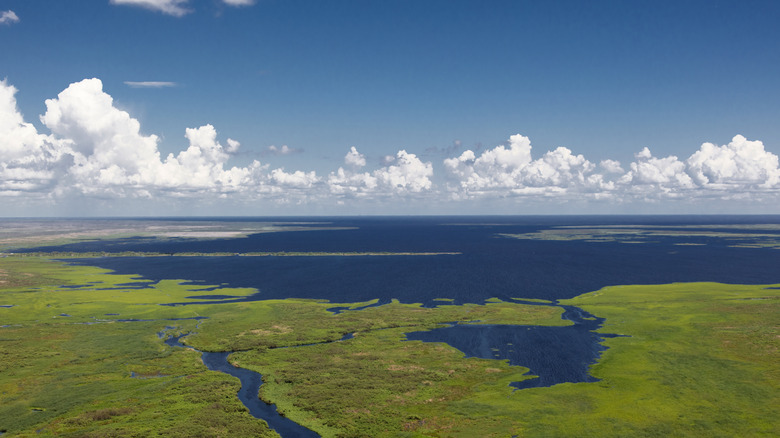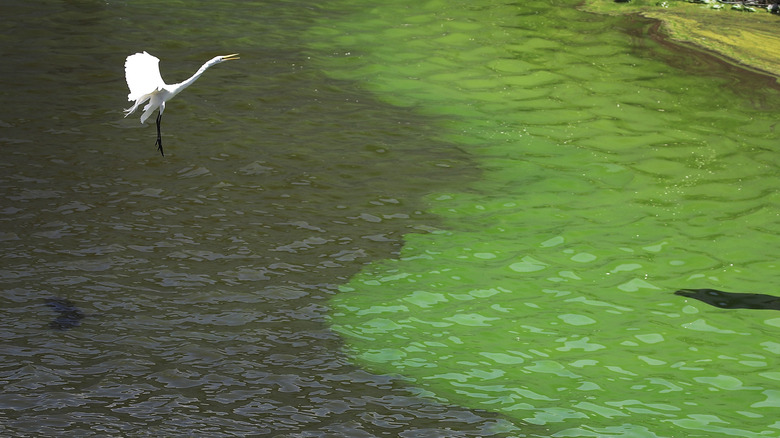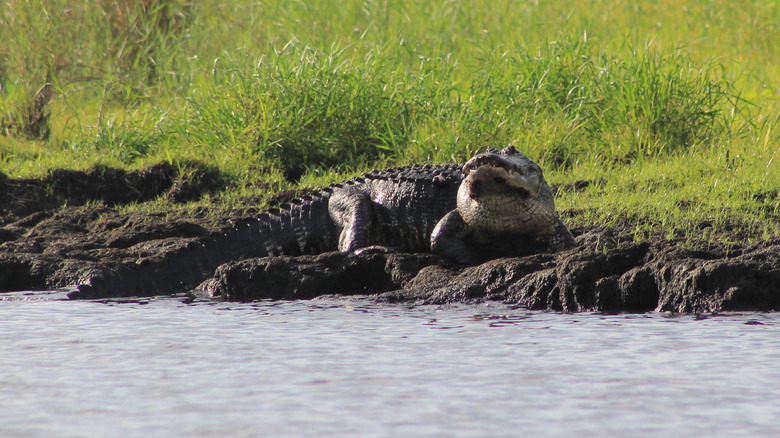The Dirtiest Lake In America Is A Dangerous Florida Destination Filled With Snakes And Gators
Lake Okeechobee's name comes from a Seminole term that means "big water," and this is certainly accurate. Okeechobee is Florida's largest freshwater lake, so big it has been dubbed the state's inland sea. As the core of the Everglades, it has also been called the liquid heart of the Sunshine State. This titanic lake, more than six times the size of Orlando, provides hundreds of miles of habitat for some of Florida's most iconic wildlife. In fact, it has even been called the Gator Capital of Florida, a state famous for having a lot of alligators to begin with. Unfortunately, it is also seriously polluted.
A study from lake.com, a vacation rental company focusing on lakeside properties, analyzed data from the National Water Quality Monitoring Council and determined that Lake Okeechobee was the dirtiest lake in the United States. As if that wasn't bad enough, that pollution has led to toxic algae blooms in the lake. While people do go boating on Okeechobee, ingesting the water can lead to illness and even death for pets and humans in rare cases.
Even if Okeechobee wasn't dealing with a toxic algae bloom, it's not a good swimming destination. What makes it so incredible is that it's a thriving ecosystem. It's one of America's most snake-filled lakes, among the best spots in America for bird lovers, and undeniably one of the most alligator-filled destinations in all of Florida. The Florida Fish and Wildlife Conservation Commission advises against swimming anywhere in Florida that isn't a designated swimming area due to the risks of encountering an alligator in the water. Considering Okeechobee is estimated to have around 33,500 alligators, splashing around in the lake is not a good idea.
What happened to the water in Lake Okeechobee?
Unfortunately, Lake Okeechobee's waters have been contaminated by agricultural runoff during Florida's rainy seasons for almost a century. This runoff water flowing into the lake is considered nutrient-rich, due to the presence of things like phosphorus and nitrogen. This sounds like a good thing, but fundamentally changing something in an ecosystem is rarely beneficial. In this case, these new water conditions are particularly good for algae. That means the lake has algae blooms, a phenomenon where an exorbitant amount of algae is able to thrive in an environment, using up all the oxygen, blocking sunlight, and choking out plants and animals that live there. This algae can also release harmful toxins.
In the case of Lake Okeechobee, the algae that grows here is blue-green algae, also known as cyanobacteria. As aquarium keepers know, that's a particularly unpleasant algae. In addition to making water neon green in high concentrations, it releases toxins that can irritate your eyes and skin, cause flu-like symptoms, do damage to the liver and nervous system, and even potentially be fatal to humans and pets in the most extreme cases. Researchers have found that water from Okeechobee in the summer of 2025 contained more than enough cyanobacteria to be dangerous to humans.
Unfortunately, this is unlikely to change any time soon. While there are plans to fix the water quality in Lake Okeechobee and the Everglades in general, the lake has been polluted for a long, long time. While any improvement is a fantastic thing for the ecosystem of the lake, it would likely take decades to make the lake safe for humans, even if all pollution were stopped today.
Wildlife safety measures at Lake Okeechobee
When you hear that Lake Okeechobee is full of snakes and alligators, you might think that it's a destination you want to avoid. But skipping a visit to the lake means you'll miss out on the opportunity to witness nature at its finest, from watching the deep red sun sink into the water at sunset from your kayak to spotting limpkins and herons in the shallows. Seeing alligators can also be a breathtaking experience, as long as you do it safely. Simply give them space and enjoy them from afar.
You'll also likely see snakes in and around the water. Florida is home to many species of snakes, including some that are venomous. You might see any number of harmless snakes like false moccasins, but you could theoretically also see actual water moccasins, which are very dangerous to people and pets. These snakes are typically shy and avoid humans. Try to avoid stepping anywhere that you can't see and take precautions with dogs.
Alligators are also generally not aggressive towards human visitors, but visitors should refrain from spending time near the shoreline. Stay back and watch them from a distance of at least 30 feet. If you're surprised by one or hear it hissing at you, slowly back away to a safe distance. Always keep your pets and small children far from the water's edge. While there have been only 30 recorded alligator deaths in Florida, there are about eight attacks every year.


